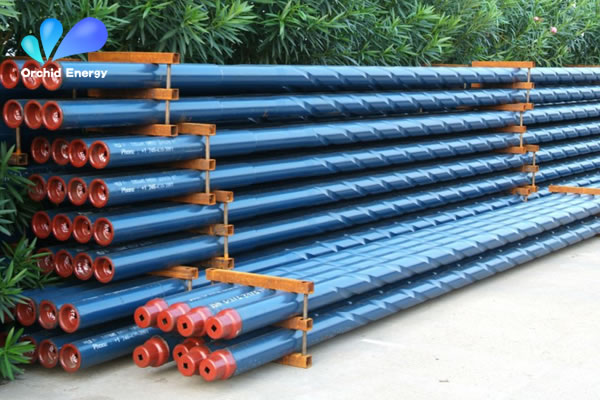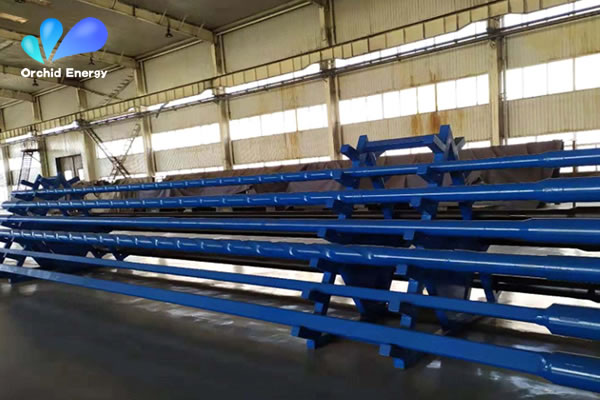Drill Pipe Explore Article 2 - Heavy Weight Drill Pipe
1. Materials Used in Heavy Weight Drill Pipes:
Heavy-weight drill pipes are typically manufactured from high-strength alloy steel, ensuring durability and performance in challenging drilling conditions. Commonly used materials include:
1.1 AISI 4145H Modified Steel:
AISI 4145H modified steel is a low-alloy steel known for its excellent mechanical properties, including high tensile and yield strength, as well as good impact and fatigue resistance.
2. Key Production Processes:
2.1 Tube Forming:
The manufacturing process begins with the forming of seamless tubes using hot-rolled or cold-drawn processes. The tubes are selected based on material specifications and are inspected for quality.
2.2 Thermal Treatment:
The tubes undergo heat treatment processes such as normalizing, quenching, and tempering to enhance their mechanical properties, ensuring they can withstand high pressures and drilling forces.
2.3 Hardbanding:
The tool joints of the heavy-weight drill pipes are hardbanded with wear-resistant alloys to protect against abrasion and extend the lifespan of the pipe connections.
2.4 Thread Welding and Cold Rolling:
The tool joints of HWDP are welded onto the drill pipe body and then undergo cold rolling to improve the strength and fatigue resistance of the connections.

3. Application Scenarios:
Heavy-weight drill pipes find extensive usage in various drilling scenarios, including:
3.1 Directional and Extended Reach Wells:
HWDP provides additional weight to the drill string, improving hole stability and preventing buckling or deviation in complex drilling trajectories, such as horizontal or extended reach wells.
3.2 Deepwater Drilling:
In deepwater drilling operations, heavy-weight drill pipes help maintain the necessary buoyancy while providing weight for efficient and controlled drilling performance.
4. International Inspection Standards:
To ensure the quality and reliability of heavy-weight drill pipes, adherence to international product inspection standards is crucial. These include:
4.1 API Spec 7-2:
API Spec 7-2 provides detailed specifications for heavy-weight drill pipes, covering dimensions, mechanical properties, chemical composition, inspection criteria, and testing methods.
4.2 DS-1®:
Developed by the International Association of Drilling Contractors (IADC) and the American Petroleum Institute (API), DS-1® is a comprehensive inspection standard for drilling equipment, including heavy-weight drill pipes.

5. Maintenance and Precautions:
Proper maintenance and adherence to precautions are essential for the safe and effective use of heavy-weight drill pipes. Consider the following:
5.1 Precautions During Use:
- Monitor the weight limits and recommended drilling parameters to prevent exceeding the pipe's load capacity.
- Ensure proper handling techniques, including careful lifting and avoiding excessive bending or loading forces.
- Periodically inspect the pipe connections for signs of wear, deformation, or damage.
5.2 Maintenance Methods:
- Clean heavy-weight drill pipes after each use to remove drilling residue and debris.
- Inspect the pipe body and connections regularly for signs of corrosion, cracks, or other defects.
- Apply protective coatings or corrosion inhibitors to safeguard against rust and extend the operational lifespan.
6. Application Cases:
Let's consider two application cases and summarize the relevant parameters in tables:
6.1 Directional Wells Case:
Drilling Operation: Horizontal Directional Well
HWDP Material: AISI 4145H Modified Steel
Drilling Depth: 7,000 ft
Bit Type: PDC Bit
| Key Parameters | Values |
| Average ROP | 80 ft/hr |
| Total Drilling Time | 14 days |
| Number of Connections | 50 |
| Total Length of HWDP | 4,000 ft |
6.2 Deepwater Drilling Case:
Drilling Operation: Deepwater Well
HWDP Material: AISI 4145H Modified Steel
Drilling Depth: 10,000 ft
Bit Type: Roller Cone Bit
| Key Parameters | Values |
| Average ROP | 40 ft/hr |
| Total Drilling Time | 30 days |
| Number of Connections | 70 |
| Total Length of HWDP | 6,000 ft |
These real application cases provide insights into the performance and parameters associated with heavy-weight drill pipes in different drilling scenarios.
Conclusion:
Heavy-weight drill pipes (HWDP) are vital components in drilling operations, providing added weight and stability to the drill string. Understanding the materials used in HWDP production processes, application scenarios, inspection standards, maintenance practices, and real application cases is crucial for maximizing efficiency and ensuring operational reliability.
HWDP is typically manufactured using AISI 4145H modified steel, known for its exceptional mechanical properties such as high tensile and yield strength, impact resistance, and fatigue resistance. Through a series of production processes including tube forming, thermal treatment, hardbanding, and thread welding, the HWDP is crafted to withstand the demanding conditions encountered during drilling operations.
Application scenarios for HWDP include directional and extended reach wells, where the added weight helps maintain stability and prevent deviation. Additionally, in deepwater drilling, HWDP provides the necessary weight while maintaining buoyancy, ensuring successful drilling operations.
Adhering to international inspection standards is vital for ensuring the quality and reliability of HWDP. Standards such as API Spec 7-2 and DS-1® provide detailed specifications regarding dimensions, mechanical properties, chemical composition, and inspection criteria, facilitating the selection and inspection of HWDP.
To ensure safe and effective use, proper maintenance and precautions should be followed. During use, it is essential to monitor weight limits, drilling parameters, and handle the HWDP carefully. Regular inspection, cleaning, and the application of protective coatings or corrosion inhibitors are vital for maintenance and extending the operational lifespan of the HWDP.
Real application cases shed light on the practical usage of HWDP and allow an understanding of key parameters. The summarized table of parameters for directional wells and deepwater drilling cases provides insights into drilling depth, average rate of penetration (ROP), total drilling time, number of connections, and total length of HWDP used.
In conclusion, understanding the materials, production processes, application scenarios, inspection standards, maintenance practices, and real application cases of heavy-weight drill pipes is essential for professionals in the drilling industry. By applying this knowledge, efficiency, reliability, and operational success can be achieved in various drilling scenarios.
Tags: Heavy Weight Drill Pipe | PDC Drill Bit




